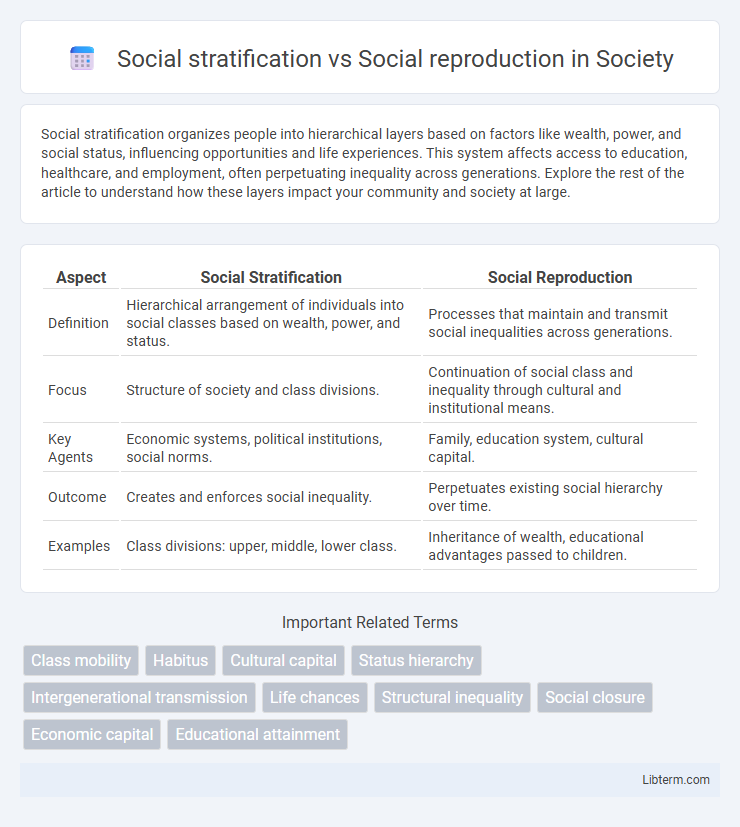Social stratification organizes people into hierarchical layers based on factors like wealth, power, and social status, influencing opportunities and life experiences. This system affects access to education, healthcare, and employment, often perpetuating inequality across generations. Explore the rest of the article to understand how these layers impact your community and society at large.
Table of Comparison
| Aspect | Social Stratification | Social Reproduction |
|---|---|---|
| Definition | Hierarchical arrangement of individuals into social classes based on wealth, power, and status. | Processes that maintain and transmit social inequalities across generations. |
| Focus | Structure of society and class divisions. | Continuation of social class and inequality through cultural and institutional means. |
| Key Agents | Economic systems, political institutions, social norms. | Family, education system, cultural capital. |
| Outcome | Creates and enforces social inequality. | Perpetuates existing social hierarchy over time. |
| Examples | Class divisions: upper, middle, lower class. | Inheritance of wealth, educational advantages passed to children. |
Understanding Social Stratification
Social stratification refers to the hierarchical arrangement of individuals in a society based on factors like wealth, power, education, and occupation, influencing access to resources and social status. Social reproduction describes the mechanisms through which social inequalities and class structures are perpetuated across generations, including family background, education systems, and cultural capital. Understanding social stratification requires analyzing how societal institutions and norms maintain or challenge these layered hierarchies, shaping individuals' life chances and social mobility.
Defining Social Reproduction
Social reproduction refers to the processes through which societies sustain and perpetuate existing social structures, including class, culture, and power relations, across generations. It encompasses the transmission of social norms, values, and economic resources that reinforce social stratification and inequality. This concept highlights how family, education, and institutional frameworks contribute to maintaining social hierarchies over time.
Key Differences Between Social Stratification and Social Reproduction
Social stratification refers to the hierarchical arrangement of individuals into social classes based on factors such as wealth, power, and prestige, while social reproduction describes the processes through which these class structures and inequalities are perpetuated across generations. Key differences include that stratification is a structural framework categorizing society, whereas reproduction emphasizes mechanisms like education, family background, and cultural capital that maintain social status over time. Social stratification highlights division and ranking, social reproduction focuses on continuity and inequality persistence.
Theories Explaining Social Stratification
Social stratification is explained by functionalist theory, which argues that social inequality is necessary for motivating individuals to fill different roles in society, while conflict theory views stratification as a result of power struggles and economic exploitation between classes. Marxist theory highlights the role of capitalism in perpetuating class divisions, emphasizing how the bourgeoisie maintain dominance over the proletariat through control of resources. Social reproduction theory, linked to sociologists like Pierre Bourdieu, focuses on how cultural capital and educational systems reinforce existing social hierarchies across generations, ensuring the persistence of social inequality.
Mechanisms of Social Reproduction
Mechanisms of social reproduction include family background, education systems, and cultural capital that maintain social stratification across generations. Access to resources, social networks, and institutional biases reinforce class positions, limiting social mobility. These processes ensure the persistence of inequality by reproducing existing power structures within society.
Impact of Social Stratification on Life Chances
Social stratification creates hierarchical layers within society, significantly influencing individuals' access to resources such as education, healthcare, and employment opportunities. This unequal distribution of resources directly impacts life chances, determining social mobility and economic success across generations. The rigid structure of social classes perpetuates disparities, limiting upward mobility and reinforcing social reproduction by maintaining existing inequalities.
Role of Education in Social Reproduction
Education plays a crucial role in social reproduction by perpetuating existing social hierarchies through the transmission of cultural capital, values, and knowledge aligned with dominant class interests. Schools often reinforce social stratification by providing unequal access to resources, influencing academic achievement and future socioeconomic status. This process ensures that social positions and power dynamics are maintained across generations, contributing to the persistence of inequality.
Intersectionality in Social Hierarchies
Social stratification organizes society into hierarchical layers based on class, race, and gender, shaping access to resources and opportunities. Social reproduction perpetuates these inequalities by transmitting cultural capital and social norms across generations, reinforcing existing power structures. Intersectionality highlights how overlapping identities, such as ethnicity and socioeconomic status, interact within social hierarchies to compound disadvantage or privilege.
Social Mobility: Barrier or Bridge?
Social stratification establishes rigid hierarchical layers that often limit social mobility, creating barriers rooted in economic inequality, education access, and cultural capital disparities. Social reproduction perpetuates these structures by transmitting established social positions across generations through family background and institutional practices. However, social mobility can act as a bridge when policies and opportunities dismantle systemic obstacles, enabling movement across social strata despite entrenched stratification.
Addressing Inequality: Strategies and Perspectives
Social stratification and social reproduction both highlight systemic inequalities, but strategies to address them emphasize policy reforms such as equitable education funding, progressive taxation, and inclusive employment practices. Perspectives on reducing inequality prioritize dismantling structural barriers that perpetuate class divisions while promoting social mobility through targeted social programs and community empowerment initiatives. Effective approaches integrate both theoretical insights and empirical evidence to create sustainable change in reducing entrenched socioeconomic disparities.
Social stratification Infographic

 libterm.com
libterm.com